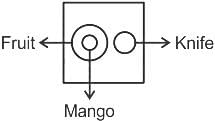APSET Paper 1 Mock Test - 5 - AP TET MCQ
30 Questions MCQ Test APSET Mock Test Series 2026 - APSET Paper 1 Mock Test - 5
Direction: Read the following passage carefully and answer the questions.
The Draft National Education Policy, 2019 (DNEP) implements the India-centric education system, which contributes to the continuous transformation of our nation into a just and vibrant knowledge society, by providing high-quality education to all. The NITI Aayog has focused policy focus specifically on education and outcomes of education from programs. It has promoted competitive federalism among states to improve their educational indicators that are measurable by a battery of tests on students. But any serious work on 'No One Left Behind' (NOLB) can ask for a new and reformist approach. DNEP has provided some hope, but it calls for further examination of rhetoric and reality.
DNEP must be read in the context of the current economic and educational climate in order to estimate the path and speed needed to make its vision a reality. On the one hand, we are in another new era of industrial revolution or skilled age. On the other hand, at present, around one million youth enter the workforce in India each month, but most of them are just raw hands without professional technical knowledge or practical business skills. The weak relationship between education and employment poses a potential risk of turning India's demographic dividend into a demographic disaster.
In the education sector, the elusive chaos of the quantity-quality-equity triangle remains unresolved. Although the merits of education are well recognized as an invaluable public, public investment for this has been minimal. It is relevant to explore how DNEP has addressed some key areas for policy interventions in school education, namely access, which can be measured by the education system, the size and flow of students crossing over to equity, which can be seen development-deprived populations, and lack or persistence of quality, which can be understood by teaching-learning processes and developmental outcomes for children that are more easily implied by attainable scores.
Q.Our Indian education sector needs:
I. To resolve the elusive conundrum of the quantity-quality-equity triangle
II. To acknowledge the merit of education as an invaluable public good
III. More public investment
IV. Policy intervention in school education
The Draft National Education Policy, 2019 (DNEP) implements the India-centric education system, which contributes to the continuous transformation of our nation into a just and vibrant knowledge society, by providing high-quality education to all. The NITI Aayog has focused policy focus specifically on education and outcomes of education from programs. It has promoted competitive federalism among states to improve their educational indicators that are measurable by a battery of tests on students. But any serious work on 'No One Left Behind' (NOLB) can ask for a new and reformist approach. DNEP has provided some hope, but it calls for further examination of rhetoric and reality.
DNEP must be read in the context of the current economic and educational climate in order to estimate the path and speed needed to make its vision a reality. On the one hand, we are in another new era of industrial revolution or skilled age. On the other hand, at present, around one million youth enter the workforce in India each month, but most of them are just raw hands without professional technical knowledge or practical business skills. The weak relationship between education and employment poses a potential risk of turning India's demographic dividend into a demographic disaster.
In the education sector, the elusive chaos of the quantity-quality-equity triangle remains unresolved. Although the merits of education are well recognized as an invaluable public, public investment for this has been minimal. It is relevant to explore how DNEP has addressed some key areas for policy interventions in school education, namely access, which can be measured by the education system, the size and flow of students crossing over to equity, which can be seen development-deprived populations, and lack or persistence of quality, which can be understood by teaching-learning processes and developmental outcomes for children that are more easily implied by attainable scores.
I. To resolve the elusive conundrum of the quantity-quality-equity triangle
II. To acknowledge the merit of education as an invaluable public good
III. More public investment
IV. Policy intervention in school education
Which of the following is not true regarding Renewable energy?
Direction: Select the Venn diagram that best represents the relationship between the following classes:
Mango, Fruit, Knife
Mango, Fruit, Knife
Directions: In making decisions about an important question, it is desirable to be able to distinguish between 'strong' arguments and 'weak' arguments. 'Strong' arguments are those which are both important and directly related to the question. 'Weak' arguments are those which are of minor importance and also may not be directly related to the question or may be related to a trivial aspect of the question.
The given question is followed by arguments numbered I and II. You have to decide which of the arguments is/are 'strong' argument(s) and which is/are 'weak' argument(s) and mark your answer accordingly.
Q. Should Indians shift their focus on other games rather than cricket, the much revered game in India, to improve performance in Olympics?
Arguments:
I. No, India has more important issues like malnutrition and lack of sanitation and hygiene to address.
II. Yes, many potential players have lost hope to make a career in sports due to lack of attention to other sports, as compared to cricket.
Which one of the following biosphere reserves has UNESCO recognition?
Direction: The following table presents the details about the number of players participating in three (3) different games (Football, Cricket and Badminton) from six (6) different countries (India, UK, Australia, Canada, Spain and USA) during the year
2020. Based on the date in the table, answer the question:
Country-wise Participation of players in Games
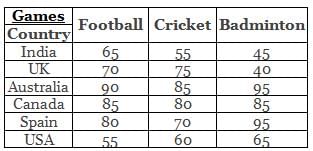
Q. What is the total number of players participating in cricket from Canada, Spain and USA and the number of players participating in Football from India, UK and Australia?
"A diagram speaks more than 1000 words." - The statement means that the teacher should
Direction: Read the information carefully and answer the following question.
For a country, CO2 emission (million metric tons) from various sectors are given in the following table.
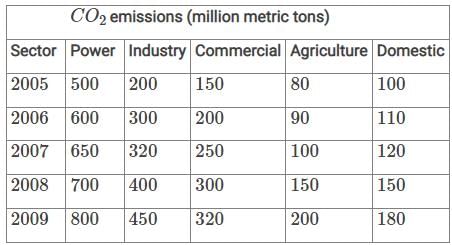
Q. What is the percentage contribution of the power sector to total CO2 emissions in the year 2008?
Direction: Read the passage given below and answer the questions by choosing the correct/most appropriate options.
More than eight months after the national lockdown was announced in late March, urban India is learning to live with the Covid-I9 pandemic. In fact, indicating a positive outlook for the future, many survey respondents in a recent survey say they plan to return to pre-lockdown levels of shopping, personal grooming, going to cinemas and socializing as pandemic fears continue to recede.
The survey findings highlight that the suppression of consumer demand because of fears of job losses and salary cuts could be coming to an end. Increasingly, urban Indians are showing increased confidence about the future of the economy. This could be an indicator of the possible 'pent-up demand' that several economists have been talking about — a demand that could be unleashed once a vaccine is developed and distributed, or when there are signs of the pandemic's spread reducing to negligible levels or vanishing totally.
Around 65 per cent of respondents said they had settled into new routines, or that they saw signs of the situation improving, or they had come to terms with the pandemic and were moving on with their lives. And since the survey was conducted before the news of the successful trials of the Pfizer vaccine for the coronavirus was announced, it is likely that the consumers are now even more positive in their outlook about the future.
Q. The general tone of the passage is that of:
Given below are two statements:
Statement I: The goal of inquiry in fundamental research is directed at bringing an increment in the fund of knowledge.
Statement II: Action research is research by the practitioner, for the practitioner, and of the practitioner.
In the light of the above statements, choose the correct answer from the options given below:
Direction: Read the passage carefully and answer the following question.
If the world is different today, we need to think, talk and engage accordingly. Falling back is unlikely to help, he said adding “purposeful pursuit of national interest is shifting global dynamics”. Highlighting India’s new approach in dealing with terrorism he compared “lack of response to the terror attack in Mumbai in comparison to the way the country responded to the Uri and Pulwama strikes. On India walking away from the Regional Comprehensive Economic Partnership, the external affair minister said no agreement was better than having a bad agreement.
Giving a historical perspective to geopolitical issues, Jai-Shankar said “For years India’s position on the world state seemed assured but the 1962 conflict with China significantly damaged India’s standing.
Q. RCEP stands for:
Directions: The question is based on the following table.
DEMAND FOR GAS (Million Cubic meters/day)
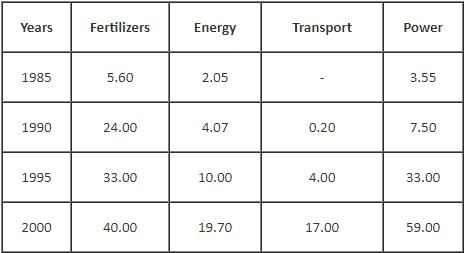
Q. In which of the given four years was fertilisers sector's demand as a percentage of total demand the lowest?
The primary responsibility for the teacher's adjustment lies with the
Direction: Read the following excerpt and answer the questions asked at the end. The answers to the questions should be based on the excerpt.
Although water covers approximately sixty seven percent of the Earth's surface, of this less than three percent is fresh water. Accounting for fresh water locked in glaciers, ice-caps or otherwise inaccessible, less than a tenth of a percent of the Earth's water is available for human consumption. Pollution, population growth and wasteful irrigation practices are contributing to a worldwide water shortage. When the clear precious liquid becomes scarce, countries begin to assert claims on fresh water supplies. As a result, drinkable water has become a region of conflict that could eventually lead to greater hostilities between nations.
Some countries such as the United States, have ample sources of water. In other nations, such as China, water is less plentiful. As water resources dwindle, competition for available sources will rise. Nations may claim rights to a particular body Of fresh water or they may plan to build dams and other projects on rivers. If two or more nations which disagree on water rights or building projects, conflicts can emerge. In order to combat this issue many countries are adopting water conservation and security solutions. The United Nations has implemented programs to combat potential issues that could lead to violence.
Q. What would be the most effective solution to avoid future conflicts among the nations?
Direction: Read the following passage carefully and answer the question.
If India has to develop her internal strengths, the nation has to focus on the technological imperatives, keeping in mind three dynamic dimensions: the people, the overall economy and the strategic interests. These technological imperatives also take into account a ‘fourth’ dimension, time, an offshoot of modern-day dynamism in business, trade, and technology that leads to continually shifting targets. We believe that technological strengths are especially crucial in dealing with this fourth dimension underlying continuous change in the aspirations of the people, the economy in the global context, and the strategic interests. The progress of technology lies at the heart of human history. Technological strengths are the key to creating more productive employment in an increasingly competitive market place and to continually upgrade human skills. Without a pervasive use of technologies, we cannot achieve the overall development of our people in the years to come. The direct linkages of technology to the nation’s strategic strengths are becoming more and more clear, especially since the 1990s. India’s own strength in a number of core areas still puts it in a position of reasonable strength in the geopolitical context. Any nation aspiring to become a developed one needs to have strengths in various strategic technologies and also the ability to continually upgrade them through its own creative strengths. For people-oriented actions as well, whether for the creation of large scale productive employment or for ensuring nutritional and health security for people or for better living conditions, technology is the only vital input. The absence of greater technological impetus could lead to lower productivity and wastage of precious natural resources. Activities with low productivity or low-value addition, in the final analysis, hurt the poorest most. The technological imperatives to lift our people to a new life, and to life, they are entitled to be important. India, aspiring to become a major economic power in terms of trade and increase in GDP, cannot succeed on the strength of turnkey projects designed and built abroad or only through large-scale imports of plant machinery, equipment and know-how. Even while being alive to the short-term realities, medium and long-term strategies to develop core technological strengths within our industry are vital for envisioning a developed India.
Q.Envisioning a developed India requires :
Match List I with List II:

Choose the correct answer from the options given below:
"The sunlight is fading, which means it will be evening very soon." - This statement is a type __________ anumana.
Direction: Study the following table chart carefully and answer the question given beside.
The following table represents the Maximum marks of five subjects and marks obtained by five students in five subjects.
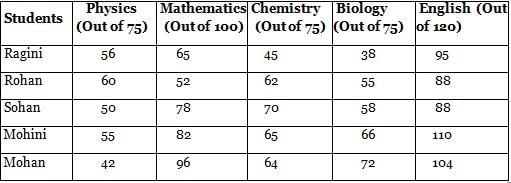
Q. Find the overall percentage of Sohan in all the subjects.
______ is the most important characteristic of a good teacher.
UNESCO published some professional requirements of a teacher, which of these are:
(A) Mastery over the subject and competency for teaching
(B) Innovativeness in approach and teaching strategies
(C) Justice to the profession of teaching
Direction: Read the following passages carefully and choose the best answer to the question.
Good health depends on several things. Fresh air and sunlight are very important for our health. Fresh air helps us to improve our immune system and overall health. So a morning walk is very useful for health. Sunlight helps our body to produce vitamin-D. A dirty and damp atmosphere causes lots of diseases. Fresh and pure drinking water is also necessary for good health. Impure drinking- water is the cause of several diseases. So, we must take care of these things. Food is another necessary thing for the body. Nutritious foods help us to maintain good health. Consumption of healthy foods helps us to minimize any health-related problems. We all should know, how, when and what to eat. We should always include a portion of green vegetables, fruits, or salads in our meals. Green vegetables are sources of vital nutrients. Our digestive system plays a key role in our overall health. Fiber-rich foods such as whole-grain wheat, bran rice, etc. help us improve our digestive system. A balanced and nutritious diet helps the proper growth of the body. But we must remember that we eat to live and not that we live to eat. In India, over-eating causes a large number of deaths. If we eat less, we may live more.
Cleanliness is essential for good health. Without cleanliness, it is very difficult to maintain proper health. We should clear our house and the surrounding areas every day. Every day, we should bathe twice, in the morning and in the evening. After eating food, we should clean our hands with soap.
Various types of diseases erupt from unclean surroundings. We should always throw the garbage in the dustbin. A disease-free body is a healthy body, and cleanliness is the key to health. We must know some simple rules of hygiene. Our house must be airy and sunny. Apart from all this, we must form good habits. We should keep ourselves free from care and anxieties. Early rising is equally necessary for good health. So we must try to keep fit. Health is the real wealth. Health is a great treasure. It is the highest blessing. It is the source of all happiness. Money can’t buy happiness. Happiness is priceless and not dependent upon the wealth of a person. Good health, however, contributes to the emotional well-being and happiness of a person. Even with limited income, a person with sound health can lead a happy and enjoyable life.
Q. What is not dependent upon the wealth of a person?
Consider the following statements about the Draft Environment Impact Assessment (EIA) Notification:
- The Ministry of Environment, Forest, and Climate Change is the nodal Ministry for notifying the EIA Notification, under the Environment (Protection) Act, 1986.
- The public reporting of the environmental violations needs to be mandatorily taken cognizance of by the authorities.
- All the off-shore projects, located beyond 12 nautical miles, are exempted from public consultation.
Which of the statements given above are correct?
Direction: Study the following line graphs and answer the given questions.
The graph shows the ratio of marks of History to Geography of 7 students in an examination.
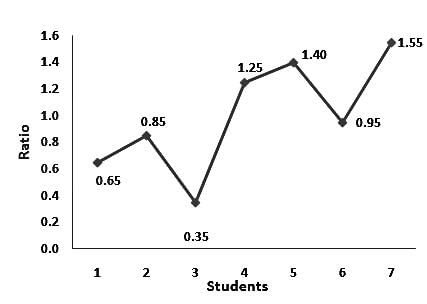
Q. Which of the following students got less marks in History than in Geography?
|
60 tests
|



